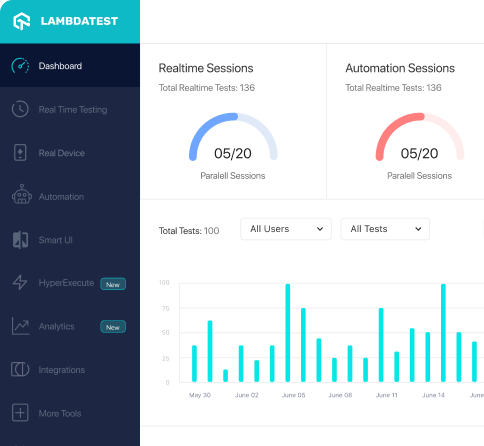How to use AbstractAssert_doesNotHaveSameHashCodeAs_Test class of org.assertj.core.api.abstract package
Best Assertj code snippet using org.assertj.core.api.abstract.AbstractAssert_doesNotHaveSameHashCodeAs_Test
Source:AbstractAssert_doesNotHaveSameHashCodeAs_Test.java
...13package org.assertj.core.api.abstract_;14import static org.mockito.Mockito.verify;15import org.assertj.core.api.AbstractAssertBaseTest;16import org.assertj.core.api.ConcreteAssert;17class AbstractAssert_doesNotHaveSameHashCodeAs_Test extends AbstractAssertBaseTest {18 @Override19 protected ConcreteAssert invoke_api_method() {20 return assertions.doesNotHaveSameHashCodeAs("Luke");21 }22 @Override23 protected void verify_internal_effects() {24 verify(objects).assertDoesNotHaveSameHashCodeAs(getInfo(assertions), getActual(assertions), "Luke");25 }26}...AbstractAssert_doesNotHaveSameHashCodeAs_Test
Using AI Code Generation
1package org.assertj.core.api;2import org.junit.Test;3public class AbstractAssert_doesNotHaveSameHashCodeAs_Test {4 public void should_pass_if_actual_does_not_have_same_hashCode_as_object() {5 new ObjectAssert("foo").doesNotHaveSameHashCodeAs("bar");6 }7 public void should_fail_if_actual_has_same_hashCode_as_object() {8 expectAssertionError("expected hashCode to be different from:<'foo'> but was:<'foo'>").on(new ObjectAssert("foo")).doesNotHaveSameHashCodeAs("foo");9 }10 public void should_fail_and_display_description_of_assertion_if_actual_has_same_hashCode_as_object() {11 expectAssertionError("[A Test] expected hashCode to be different from:<'foo'> but was:<'foo'>").on(new ObjectAssert("foo")).as("A Test")12 .doesNotHaveSameHashCodeAs("foo");13 }14 public void should_fail_with_custom_message_if_actual_has_same_hashCode_as_object() {15 expectAssertionError("My custom message").on(new ObjectAssert("foo")).overridingErrorMessage("My custom message")16 .doesNotHaveSameHashCodeAs("foo");17 }18 public void should_fail_with_custom_message_ignoring_description_of_assertion_if_actual_has_same_hashCode_as_object() {19 expectAssertionError("My custom message").on(new ObjectAssert("foo")).as("A Test")20 .overridingErrorMessage("My custom message")21 .doesNotHaveSameHashCodeAs("foo");22 }23}24package org.assertj.core.api;25import org.junit.Test;26public class AbstractAssert_hasSameHashCodeAs_Test {27 public void should_pass_if_actual_has_same_hashCode_as_object() {28 new ObjectAssert("foo").hasSameHashCodeAs("foo");29 }30 public void should_fail_if_actual_does_not_have_same_hashCode_as_object() {31 expectAssertionError("expected hashCode to be:<'foo'> but was:<'bar'>").on(new ObjectAssert("bar")).hasSameHashCodeAs("foo");32 }33 public void should_fail_and_display_description_of_assertion_if_actual_does_not_have_same_hashCode_as_object() {34 expectAssertionError("[A Test] expected hashCode to be:<'foo'> but was:<'bar'>").on(new ObjectAssert("Blogs
Check out the latest blogs from LambdaTest on this topic:
While there is a huge demand and need to run Selenium Test Automation, the experts always suggest not to automate every possible test. Exhaustive Testing is not possible, and Automating everything is not sustainable.
JUnit is one of the most popular unit testing frameworks in the Java ecosystem. The JUnit 5 version (also known as Jupiter) contains many exciting innovations, including support for new features in Java 8 and above. However, many developers still prefer to use the JUnit 4 framework since certain features like parallel execution with JUnit 5 are still in the experimental phase.
The fact is not alien to us anymore that cross browser testing is imperative to enhance your application’s user experience. Enhanced knowledge of popular and highly acclaimed testing frameworks goes a long way in developing a new app. It holds more significance if you are a full-stack developer or expert programmer.
When most firms employed a waterfall development model, it was widely joked about in the industry that Google kept its products in beta forever. Google has been a pioneer in making the case for in-production testing. Traditionally, before a build could go live, a tester was responsible for testing all scenarios, both defined and extempore, in a testing environment. However, this concept is evolving on multiple fronts today. For example, the tester is no longer testing alone. Developers, designers, build engineers, other stakeholders, and end users, both inside and outside the product team, are testing the product and providing feedback.
Automation Testing Tutorials
Learn to execute automation testing from scratch with LambdaTest Learning Hub. Right from setting up the prerequisites to run your first automation test, to following best practices and diving deeper into advanced test scenarios. LambdaTest Learning Hubs compile a list of step-by-step guides to help you be proficient with different test automation frameworks i.e. Selenium, Cypress, TestNG etc.
LambdaTest Learning Hubs:
- JUnit Tutorial
- TestNG Tutorial
- Webdriver Tutorial
- WebDriverIO Tutorial
- Protractor Tutorial
- Selenium 4 Tutorial
- Jenkins Tutorial
- NUnit Tutorial
- Jest Tutorial
- Playwright Tutorial
- Cypress Tutorial
- PyTest Tutorial
YouTube
You could also refer to video tutorials over LambdaTest YouTube channel to get step by step demonstration from industry experts.
Most used methods in AbstractAssert_doesNotHaveSameHashCodeAs_Test
Try LambdaTest Now !!
Get 100 minutes of automation test minutes FREE!!



